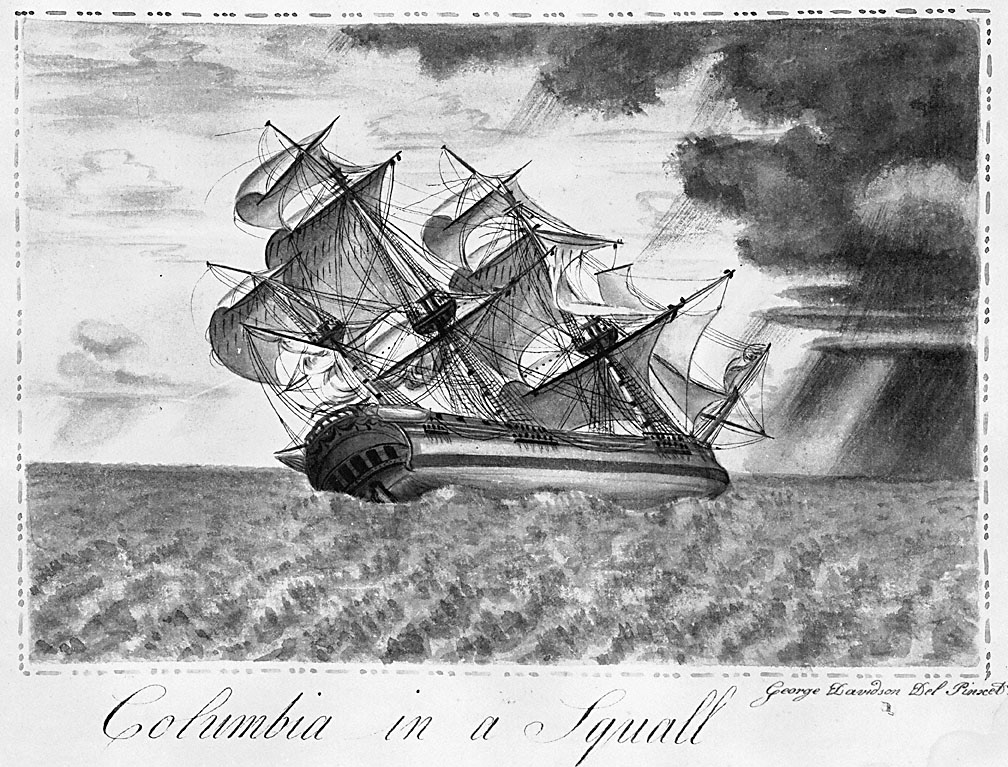- Catalog No. —
- OrHi 984
- Date —
- 1793
- Era —
- 1792-1845 (Early Exploration, Fur Trade, Missionaries, and Settlement)
- Themes —
- Exploration and Explorers, Geography and Places
- Credits —
- Oregon Historical Society
- Regions —
- Coast Oregon Country
- Author —
- George Davidson
Columbia in a Squall
This painting shows the Columbia Rediviva heeling to the side as it approaches a squall. It was painted in 1793 by amateur artist George Davidson, the Columbia’s painter. This illustration gives a sense of the danger associated with the long voyages at sea undertaken by maritime fur traders.
The Columbia Rediviva, an 83-foot-long, 212-ton ship, left Boston Harbor for the Northwest Coast on October 1, 1790, with a complement of thirty-one men and boys. It was her second voyage to the Northwest Coast in search of furs. Robert Gray captained the ship; his first officer was Robert Haswell, a twenty-one-year-old native of Massachusetts. The youngest member of the crew was Samuel Homer, a cabin boy who was probably eleven or twelve when the Columbia left Boston.
The voyage to the Northwest Coast from Boston took a full eight months, during which time the Columbia encountered numerous storms. The Columbia came close to disaster in January 1791 while cruising off the southeastern coast of South America. John Hoskins, the ship’s supercargo, wrote that the weather suddenly grew “thick and hazy, the wind increas’d into a strong gale, and the sea became mountainous.” They were driven uncontrollably into shallow waters; however, Hoskins wrote, “Captain Gray very prudently ordered their to be no sounding; as it would only increase our fears, without a possibility of lessening our danger. thus was our situation truly alarming; there being to all appearance but a short space between us, and eternity….” The storm finally abated late that evening, and the Columbia was able to continue along its way with minimal damage.
Storms were not the only danger the crew of the Columbia faced. During the long journey to the Northwest Coast most of the men came down with scurvy, a potentially fatal disease caused by a lack of vitamin C in the diet. Hoskins wrote in his journal: “their is scare a person on board the ship but what has felt, more or less, the banefull effects of this dreadfull distemper….”
After nearly three years at sea, the Columbia returned to Boston on July 25, 1793, with all but four of her original crew. Three had been killed by Natives in present-day Alaska, the fourth died of dysentery. Although most of the Columbia’s crew managed to return safely, several were not so lucky on subsequent voyages, including John Hoskins and George Davidson, both of whom were lost at sea in 1801.
Further Reading:
Howay, Frederic W., ed. Voyages of the “Columbia” to the Northwest Coast, 1787-1790 and 1790-1793. Portland, Oreg., 1990.
Nokes, Richard J. Columbia’s River: The Voyages of Robert Gray, 1787-1793. Tacoma, Wash., 1991.
Scofield, John. Hail, Columbia: Robert Gray, John Kendrick, and the Pacific Fur Trade. Portland, Oreg., 1993.
Written by Cain Allen, © Oregon Historical Society, 2006.
